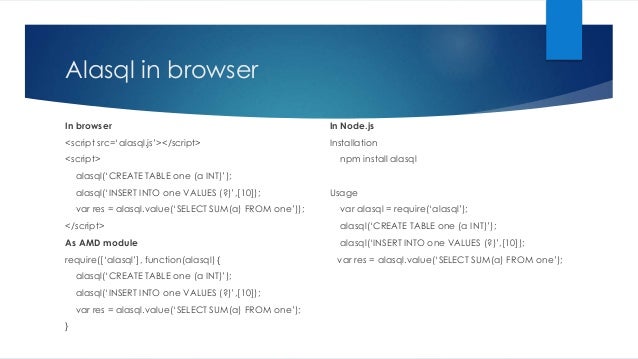
EXISTS Performance - Stack. If you want to check for existence and if a value exist you need a column from the other table, joins are preferred. You can find more T- SQL tips in this overview.
If you are using the IN operator, the SQL engine will scan all records fetched from the inner query. SQL Server, Syndication, T- SQL This one’s come up a few times recently, so I’ll take a look at it. Not many of them had prior programming experience, much less SQL exposure, so it was a fun week to learn how well us instructors could teach the topic. Chose carefully which you want.
Columns that will never contain NULL values should be defined as NOT NULL so that SQL knows there will never be NULL values in them and so that it doesn’t have to produce complex plans to handle potential nulls. SQL is tied to the T- SQL that has a proprietary programming construct. SQL Server works exclusively for the Microsoft environment for more than years now. Ett stort urval av Eaton Möller produkter nu i lager hos Elfa Distrelec!
In this case, SQL Server cannot use the Left Semi Join method. Instea it first removes all duplicates of valfrom t_inner using Hash. Obviously there must be a reason behind it. ANY and ALL are all SQL logical operators used in conjunction with sub-query. For explanation let us consider a table customers customers(Name, Age, Salary) This.
September 8:am UTC. The exception to this rule is if the optimizer is not able to expand the query. In that case the optimizer might select a suboptimal query plan. Faris Hilmi presents the highlights of the latest SQL Prompt 9. They produce the safe efficient plans with some kind of an Anti Join.
On the first example, you get all columns from both A and B, whereas in the second example, you get only columns from A. Also discussed SQL Exists with group by, SQL Exists with IN, SQL NOT Exists with description. I need to know which is faster not in or not exists in a query? Los dos operadores pueden producir los mismos resultados, pero no siempre lo hacen. También existe un debate considerable sobre cómo es optimizado cada operador para ser veloz.
Few days ago I wrote article about SQL SERVER – Stored Procedure Optimization Tips. The SQL Server Not exists is used to restrict total rows returned by SELECT Statement. You should also specify THEN. To me, this is really long statement to read to see if a row exists in a table.
Answer: As we know, SQL is declarative and there are many equivalent ways to write a query that gives the same. This is especially true for using the IN vs. The Oracle documentation notes that: If the selective predicate is in the subquery, then use IN. While they are logically different, many people say that they are identical in terms of performance. I know they may seem very close to the same, but they are not.
It can be used in a SELECT, UPDATE, INSERT or DELETE statement. Solved: Hello, Could someone please explain me the Exists function in Qlikview and SQL. SQL HOME SQL Intro SQL Syntax SQL Select SQL Select Distinct SQL Where SQL An Or, Not SQL Order By SQL Insert Into SQL Null Values SQL Update SQL Delete SQL Select Top SQL Min and Max SQL Count, Avg, Sum SQL Like SQL Wildcards SQL In SQL Between SQL Aliases SQL Joins SQL Inner Join SQL Left Join SQL Right Join SQL Full Join SQL Self Join SQL Union SQL Group By SQL Having SQL Exists SQL Any. For example, the following query subsets PROCLIB.

Description of the illustration exists _condition.
Inga kommentarer:
Skicka en kommentar
Obs! Endast bloggmedlemmar kan kommentera.